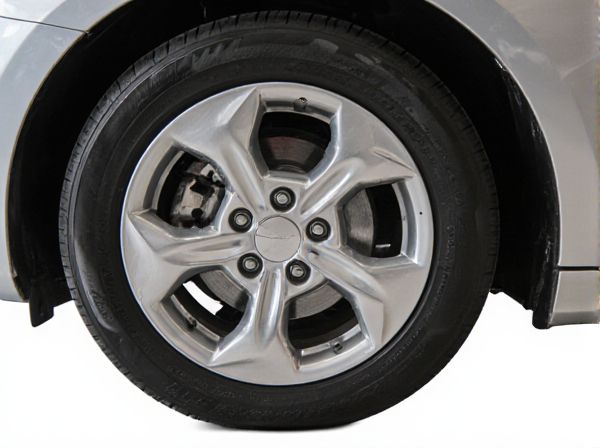
Photo illustration: Hub-centric vs Lug-centric
Hub-centric wheels align perfectly with the vehicle's hub, ensuring precise fit and reducing vibrations for a smoother ride. Lug-centric wheels rely on the lug nuts to center the wheel, which may cause slight misalignment or uneven pressure distribution. Understanding the difference helps you choose wheels that enhance stability, safety, and overall driving experience.
Table of Comparison
| Feature | Hub-Centric Wheels | Lug-Centric Wheels |
|---|---|---|
| Centering Method | Wheel centers on the hub bore | Wheel centers on the lug nuts |
| Fitment Precision | Higher precision and alignment | Less precise, relies on lug tightening |
| Vibration | Reduced vibrations and wobble | Possible vibrations if lug torque is uneven |
| Installation | Easy to align before lug tightening | Requires careful lug nut torqueing |
| Application | Common in OEM and performance wheels | Often found in aftermarket or older wheels |
| Durability | Less wear on lugs, longer lifespan | More stress on lug nuts and studs |
Introduction to Wheel Centering Methods
Hub-centric wheels align precisely with the vehicle hub using the center bore, ensuring minimal vibration and improved stability by distributing the load directly through the hub. Lug-centric wheels rely on the lug nuts or bolts to center the wheel on the hub, which may introduce slight misalignment and increased risk of vibration under certain conditions. Choosing between hub-centric and lug-centric depends on the vehicle specifications and desired performance, with hub-centric providing more precise wheel centering and better handling.
What is Hub-Centric?
Hub-centric refers to a wheel mounting design where the wheel's center hole precisely matches the vehicle's hub diameter, ensuring the wheel is perfectly centered on the hub. This alignment minimizes vibrations and enhances driving stability, as the hub supports the vehicle's weight rather than relying solely on lug nuts. Hub-centric wheels improve safety and performance by distributing forces evenly across the hub assembly.
What is Lug-Centric?
Lug-centric design focuses on the wheel lugs bearing the primary load and securing the wheel to the hub, minimizing stress on the hub itself. This approach contrasts with hub-centric design, where the hub bore centers the wheel to the hub, ensuring precise fitment and load distribution. Lug-centric wheels rely on the lug nuts or bolts to maintain alignment and stability during vehicle operation.
Key Differences Between Hub-Centric and Lug-Centric
Hub-centric wheels center on the hub flange for alignment, ensuring precise fitment and reducing stress on lug nuts, which enhances wheel stability and safety. Lug-centric wheels rely on the lug nuts for centering, which can cause uneven stress distribution and potential wheel misalignment, especially under heavy loads. The key difference lies in the centering mechanism: hub-centric offers superior alignment by fitting snugly on the hub, while lug-centric depends on lug nut torque for positioning.
Advantages of Hub-Centric Wheels
Hub-centric wheels provide a precise fit by centering directly on the hub, reducing vibrations and improving ride quality compared to lug-centric designs. This accurate alignment enhances safety by evenly distributing stress across the wheel mounting surface, minimizing the risk of wheel loosening. The hub-centric system also simplifies installation and maintenance by ensuring wheels self-center on the hub during mounting.
Benefits of Lug-Centric Wheels
Lug-centric wheels provide a more secure fit by centering the wheel on the lug nuts, which reduces the risk of wheel wobble and vibration during driving. They often require less maintenance since the lug nuts bear the load, minimizing stress on the wheel hub and preventing potential damage to the wheel bearings. This design is especially beneficial for vehicles with steel wheels or aftermarket rims, ensuring safer and more reliable performance on various road conditions.
Common Issues with Hub-Centric Fitment
Common issues with hub-centric fitment include vibrations due to improper hub alignment, which occurs when the wheel bore does not match the vehicle's hub accurately, causing uneven load distribution. This misalignment can lead to premature wheel bearing wear and compromised vehicle stability. Ensuring precise hub bore dimensions and using appropriate hub-centric rings are critical to maintaining optimal fitment and avoiding these problems.
Potential Problems with Lug-Centric Installations
Lug-centric wheel installations can cause uneven stress distribution on wheel bolts or studs, increasing the risk of loosening or failure during operation. This misalignment often leads to quicker wear on suspension components and potential vibrations, compromising vehicle safety and performance. Thread stripping and wheel detachment are common issues due to the concentrated load on the lugs instead of the hub's central flange.
Choosing the Right Wheel Centering for Your Vehicle
Choosing between hub-centric and lug-centric wheel centering depends on your vehicle's design and intended use, as hub-centric wheels align with the hub's center bore for precise fitment and balanced rotation. Lug-centric wheels rely on the lug nuts to center the wheel, which may be suitable for certain aftermarket setups but can lead to vibrations if not properly installed. Ensuring the wheel matches your vehicle's hub size and centering method enhances safety, performance, and comfort during driving.
Hub-Centric vs Lug-Centric: Final Comparison and Recommendations
Hub-centric wheels align perfectly with the vehicle's hub, ensuring precise fitment and balanced load distribution, reducing vibration and enhancing ride quality. Lug-centric wheels rely on the lug nuts for centering, which can sometimes cause misalignment or stress on the studs, impacting safety and performance. For optimal stability and long-term durability, hub-centric designs are generally recommended, especially for high-performance or heavy-duty vehicles, while lug-centric may suffice for casual use with correct torque and maintenance.
 caratoz.com
caratoz.com